FBL5020 Marketing Leadership Report: Buyer Decision Process
VerifiedAdded on 2022/11/23
|8
|1646
|187
Report
AI Summary
This report analyzes the buyer decision processes of three individuals – Gino, Brett, and Alex – within a car purchasing scenario, examining the influence of situational factors, Maslow's hierarchy of needs, and cost-benefit risk analysis. The report addresses four key questions, exploring how these fact...
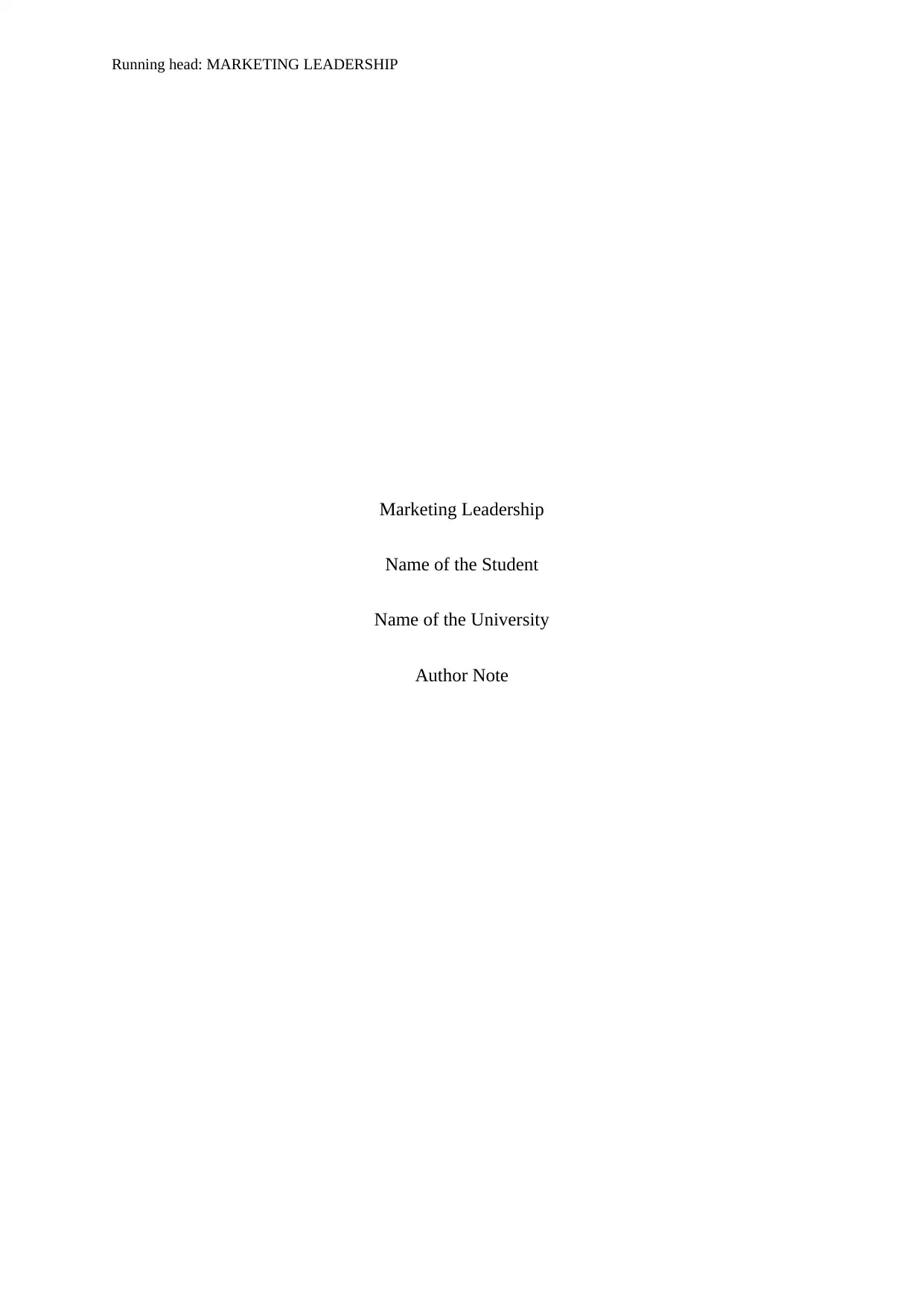
Running head: MARKETING LEADERSHIP
Marketing Leadership
Name of the Student
Name of the University
Author Note
Marketing Leadership
Name of the Student
Name of the University
Author Note
Paraphrase This Document
Need a fresh take? Get an instant paraphrase of this document with our AI Paraphraser
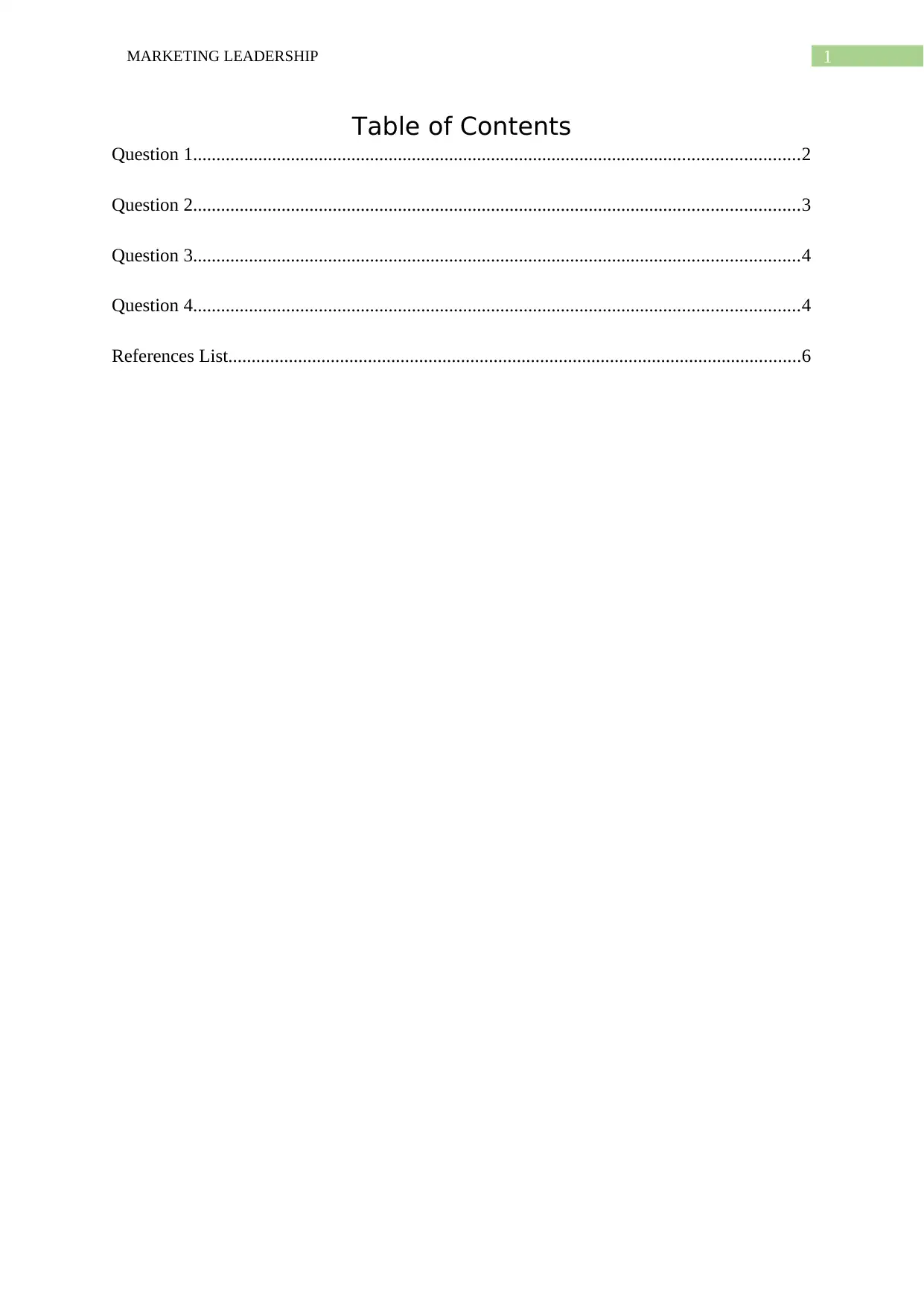
1MARKETING LEADERSHIP
Table of Contents
Question 1..................................................................................................................................2
Question 2..................................................................................................................................3
Question 3..................................................................................................................................4
Question 4..................................................................................................................................4
References List...........................................................................................................................6
Table of Contents
Question 1..................................................................................................................................2
Question 2..................................................................................................................................3
Question 3..................................................................................................................................4
Question 4..................................................................................................................................4
References List...........................................................................................................................6
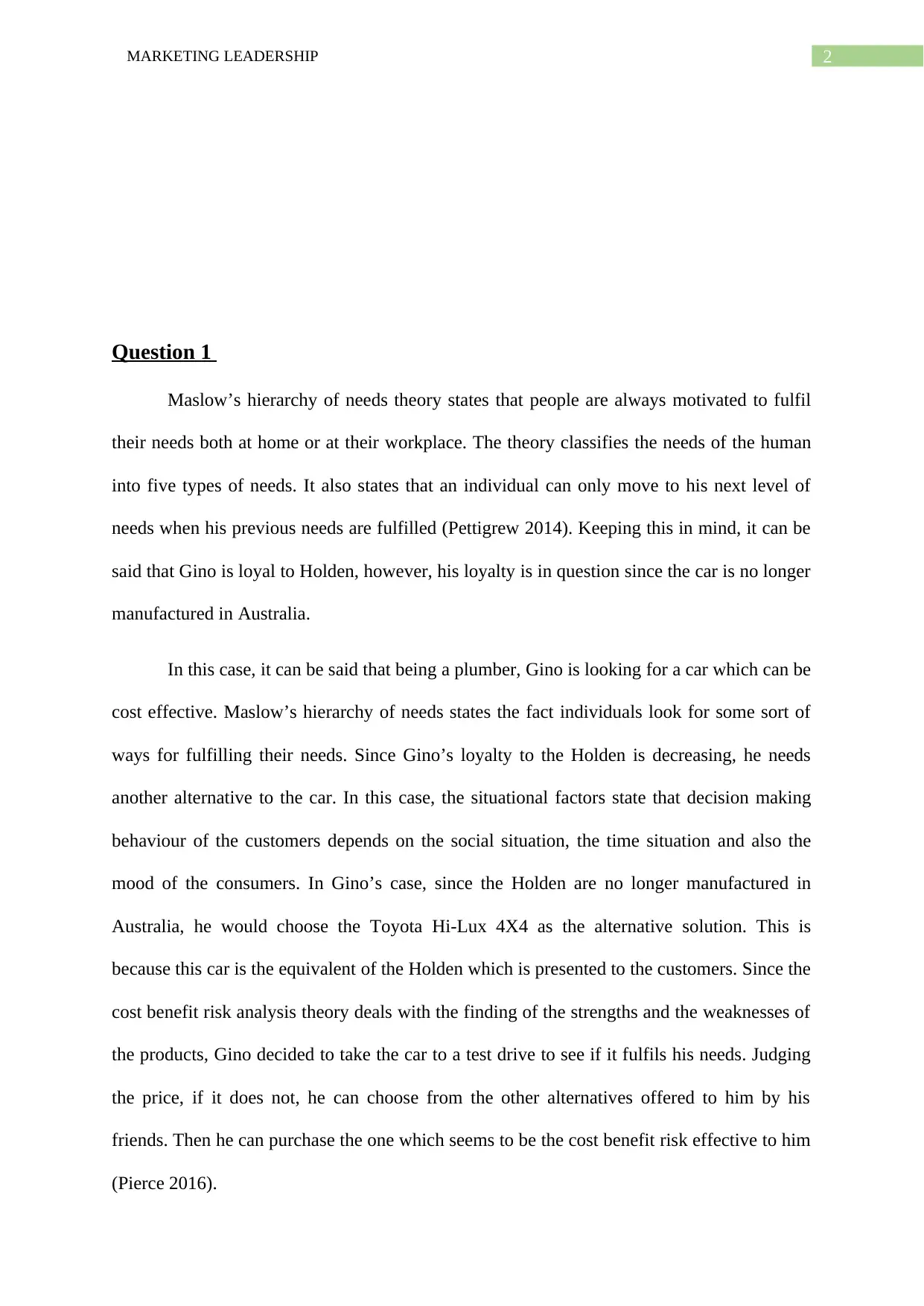
2MARKETING LEADERSHIP
Question 1
Maslow’s hierarchy of needs theory states that people are always motivated to fulfil
their needs both at home or at their workplace. The theory classifies the needs of the human
into five types of needs. It also states that an individual can only move to his next level of
needs when his previous needs are fulfilled (Pettigrew 2014). Keeping this in mind, it can be
said that Gino is loyal to Holden, however, his loyalty is in question since the car is no longer
manufactured in Australia.
In this case, it can be said that being a plumber, Gino is looking for a car which can be
cost effective. Maslow’s hierarchy of needs states the fact individuals look for some sort of
ways for fulfilling their needs. Since Gino’s loyalty to the Holden is decreasing, he needs
another alternative to the car. In this case, the situational factors state that decision making
behaviour of the customers depends on the social situation, the time situation and also the
mood of the consumers. In Gino’s case, since the Holden are no longer manufactured in
Australia, he would choose the Toyota Hi-Lux 4X4 as the alternative solution. This is
because this car is the equivalent of the Holden which is presented to the customers. Since the
cost benefit risk analysis theory deals with the finding of the strengths and the weaknesses of
the products, Gino decided to take the car to a test drive to see if it fulfils his needs. Judging
the price, if it does not, he can choose from the other alternatives offered to him by his
friends. Then he can purchase the one which seems to be the cost benefit risk effective to him
(Pierce 2016).
Question 1
Maslow’s hierarchy of needs theory states that people are always motivated to fulfil
their needs both at home or at their workplace. The theory classifies the needs of the human
into five types of needs. It also states that an individual can only move to his next level of
needs when his previous needs are fulfilled (Pettigrew 2014). Keeping this in mind, it can be
said that Gino is loyal to Holden, however, his loyalty is in question since the car is no longer
manufactured in Australia.
In this case, it can be said that being a plumber, Gino is looking for a car which can be
cost effective. Maslow’s hierarchy of needs states the fact individuals look for some sort of
ways for fulfilling their needs. Since Gino’s loyalty to the Holden is decreasing, he needs
another alternative to the car. In this case, the situational factors state that decision making
behaviour of the customers depends on the social situation, the time situation and also the
mood of the consumers. In Gino’s case, since the Holden are no longer manufactured in
Australia, he would choose the Toyota Hi-Lux 4X4 as the alternative solution. This is
because this car is the equivalent of the Holden which is presented to the customers. Since the
cost benefit risk analysis theory deals with the finding of the strengths and the weaknesses of
the products, Gino decided to take the car to a test drive to see if it fulfils his needs. Judging
the price, if it does not, he can choose from the other alternatives offered to him by his
friends. Then he can purchase the one which seems to be the cost benefit risk effective to him
(Pierce 2016).
You're viewing a preview
Unlock full access by subscribing today!
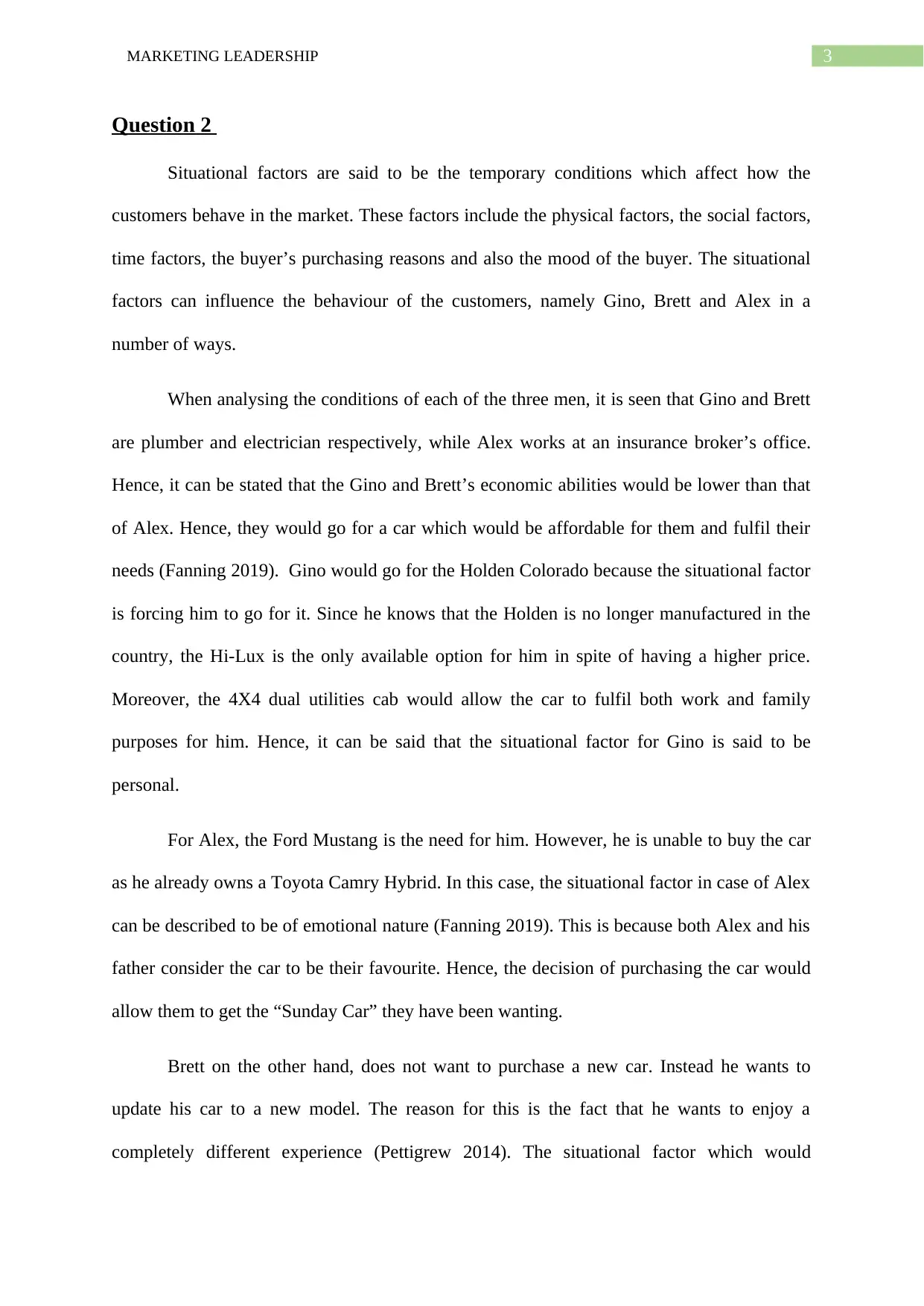
3MARKETING LEADERSHIP
Question 2
Situational factors are said to be the temporary conditions which affect how the
customers behave in the market. These factors include the physical factors, the social factors,
time factors, the buyer’s purchasing reasons and also the mood of the buyer. The situational
factors can influence the behaviour of the customers, namely Gino, Brett and Alex in a
number of ways.
When analysing the conditions of each of the three men, it is seen that Gino and Brett
are plumber and electrician respectively, while Alex works at an insurance broker’s office.
Hence, it can be stated that the Gino and Brett’s economic abilities would be lower than that
of Alex. Hence, they would go for a car which would be affordable for them and fulfil their
needs (Fanning 2019). Gino would go for the Holden Colorado because the situational factor
is forcing him to go for it. Since he knows that the Holden is no longer manufactured in the
country, the Hi-Lux is the only available option for him in spite of having a higher price.
Moreover, the 4X4 dual utilities cab would allow the car to fulfil both work and family
purposes for him. Hence, it can be said that the situational factor for Gino is said to be
personal.
For Alex, the Ford Mustang is the need for him. However, he is unable to buy the car
as he already owns a Toyota Camry Hybrid. In this case, the situational factor in case of Alex
can be described to be of emotional nature (Fanning 2019). This is because both Alex and his
father consider the car to be their favourite. Hence, the decision of purchasing the car would
allow them to get the “Sunday Car” they have been wanting.
Brett on the other hand, does not want to purchase a new car. Instead he wants to
update his car to a new model. The reason for this is the fact that he wants to enjoy a
completely different experience (Pettigrew 2014). The situational factor which would
Question 2
Situational factors are said to be the temporary conditions which affect how the
customers behave in the market. These factors include the physical factors, the social factors,
time factors, the buyer’s purchasing reasons and also the mood of the buyer. The situational
factors can influence the behaviour of the customers, namely Gino, Brett and Alex in a
number of ways.
When analysing the conditions of each of the three men, it is seen that Gino and Brett
are plumber and electrician respectively, while Alex works at an insurance broker’s office.
Hence, it can be stated that the Gino and Brett’s economic abilities would be lower than that
of Alex. Hence, they would go for a car which would be affordable for them and fulfil their
needs (Fanning 2019). Gino would go for the Holden Colorado because the situational factor
is forcing him to go for it. Since he knows that the Holden is no longer manufactured in the
country, the Hi-Lux is the only available option for him in spite of having a higher price.
Moreover, the 4X4 dual utilities cab would allow the car to fulfil both work and family
purposes for him. Hence, it can be said that the situational factor for Gino is said to be
personal.
For Alex, the Ford Mustang is the need for him. However, he is unable to buy the car
as he already owns a Toyota Camry Hybrid. In this case, the situational factor in case of Alex
can be described to be of emotional nature (Fanning 2019). This is because both Alex and his
father consider the car to be their favourite. Hence, the decision of purchasing the car would
allow them to get the “Sunday Car” they have been wanting.
Brett on the other hand, does not want to purchase a new car. Instead he wants to
update his car to a new model. The reason for this is the fact that he wants to enjoy a
completely different experience (Pettigrew 2014). The situational factor which would
Paraphrase This Document
Need a fresh take? Get an instant paraphrase of this document with our AI Paraphraser
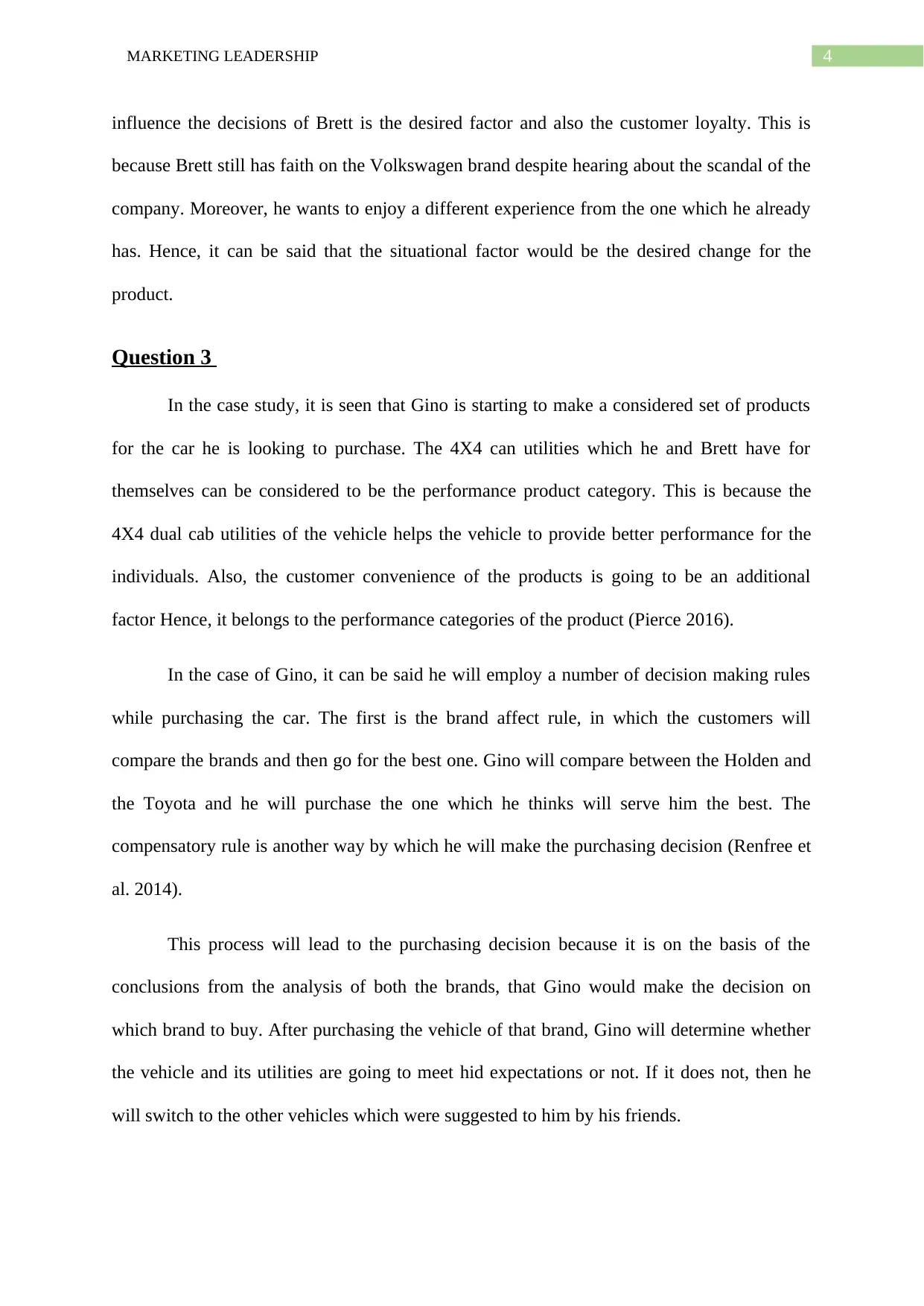
4MARKETING LEADERSHIP
influence the decisions of Brett is the desired factor and also the customer loyalty. This is
because Brett still has faith on the Volkswagen brand despite hearing about the scandal of the
company. Moreover, he wants to enjoy a different experience from the one which he already
has. Hence, it can be said that the situational factor would be the desired change for the
product.
Question 3
In the case study, it is seen that Gino is starting to make a considered set of products
for the car he is looking to purchase. The 4X4 can utilities which he and Brett have for
themselves can be considered to be the performance product category. This is because the
4X4 dual cab utilities of the vehicle helps the vehicle to provide better performance for the
individuals. Also, the customer convenience of the products is going to be an additional
factor Hence, it belongs to the performance categories of the product (Pierce 2016).
In the case of Gino, it can be said he will employ a number of decision making rules
while purchasing the car. The first is the brand affect rule, in which the customers will
compare the brands and then go for the best one. Gino will compare between the Holden and
the Toyota and he will purchase the one which he thinks will serve him the best. The
compensatory rule is another way by which he will make the purchasing decision (Renfree et
al. 2014).
This process will lead to the purchasing decision because it is on the basis of the
conclusions from the analysis of both the brands, that Gino would make the decision on
which brand to buy. After purchasing the vehicle of that brand, Gino will determine whether
the vehicle and its utilities are going to meet hid expectations or not. If it does not, then he
will switch to the other vehicles which were suggested to him by his friends.
influence the decisions of Brett is the desired factor and also the customer loyalty. This is
because Brett still has faith on the Volkswagen brand despite hearing about the scandal of the
company. Moreover, he wants to enjoy a different experience from the one which he already
has. Hence, it can be said that the situational factor would be the desired change for the
product.
Question 3
In the case study, it is seen that Gino is starting to make a considered set of products
for the car he is looking to purchase. The 4X4 can utilities which he and Brett have for
themselves can be considered to be the performance product category. This is because the
4X4 dual cab utilities of the vehicle helps the vehicle to provide better performance for the
individuals. Also, the customer convenience of the products is going to be an additional
factor Hence, it belongs to the performance categories of the product (Pierce 2016).
In the case of Gino, it can be said he will employ a number of decision making rules
while purchasing the car. The first is the brand affect rule, in which the customers will
compare the brands and then go for the best one. Gino will compare between the Holden and
the Toyota and he will purchase the one which he thinks will serve him the best. The
compensatory rule is another way by which he will make the purchasing decision (Renfree et
al. 2014).
This process will lead to the purchasing decision because it is on the basis of the
conclusions from the analysis of both the brands, that Gino would make the decision on
which brand to buy. After purchasing the vehicle of that brand, Gino will determine whether
the vehicle and its utilities are going to meet hid expectations or not. If it does not, then he
will switch to the other vehicles which were suggested to him by his friends.
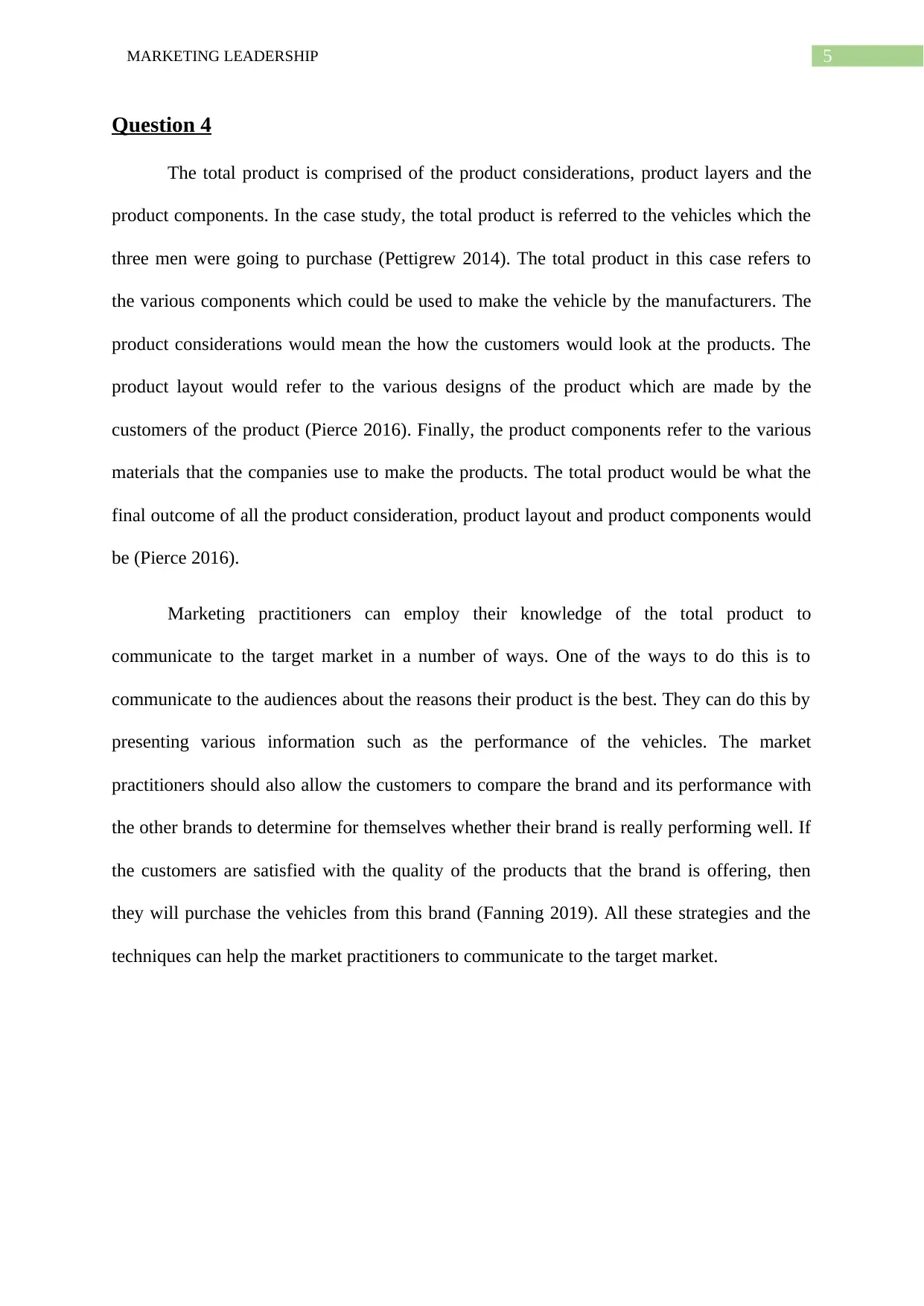
5MARKETING LEADERSHIP
Question 4
The total product is comprised of the product considerations, product layers and the
product components. In the case study, the total product is referred to the vehicles which the
three men were going to purchase (Pettigrew 2014). The total product in this case refers to
the various components which could be used to make the vehicle by the manufacturers. The
product considerations would mean the how the customers would look at the products. The
product layout would refer to the various designs of the product which are made by the
customers of the product (Pierce 2016). Finally, the product components refer to the various
materials that the companies use to make the products. The total product would be what the
final outcome of all the product consideration, product layout and product components would
be (Pierce 2016).
Marketing practitioners can employ their knowledge of the total product to
communicate to the target market in a number of ways. One of the ways to do this is to
communicate to the audiences about the reasons their product is the best. They can do this by
presenting various information such as the performance of the vehicles. The market
practitioners should also allow the customers to compare the brand and its performance with
the other brands to determine for themselves whether their brand is really performing well. If
the customers are satisfied with the quality of the products that the brand is offering, then
they will purchase the vehicles from this brand (Fanning 2019). All these strategies and the
techniques can help the market practitioners to communicate to the target market.
Question 4
The total product is comprised of the product considerations, product layers and the
product components. In the case study, the total product is referred to the vehicles which the
three men were going to purchase (Pettigrew 2014). The total product in this case refers to
the various components which could be used to make the vehicle by the manufacturers. The
product considerations would mean the how the customers would look at the products. The
product layout would refer to the various designs of the product which are made by the
customers of the product (Pierce 2016). Finally, the product components refer to the various
materials that the companies use to make the products. The total product would be what the
final outcome of all the product consideration, product layout and product components would
be (Pierce 2016).
Marketing practitioners can employ their knowledge of the total product to
communicate to the target market in a number of ways. One of the ways to do this is to
communicate to the audiences about the reasons their product is the best. They can do this by
presenting various information such as the performance of the vehicles. The market
practitioners should also allow the customers to compare the brand and its performance with
the other brands to determine for themselves whether their brand is really performing well. If
the customers are satisfied with the quality of the products that the brand is offering, then
they will purchase the vehicles from this brand (Fanning 2019). All these strategies and the
techniques can help the market practitioners to communicate to the target market.
You're viewing a preview
Unlock full access by subscribing today!
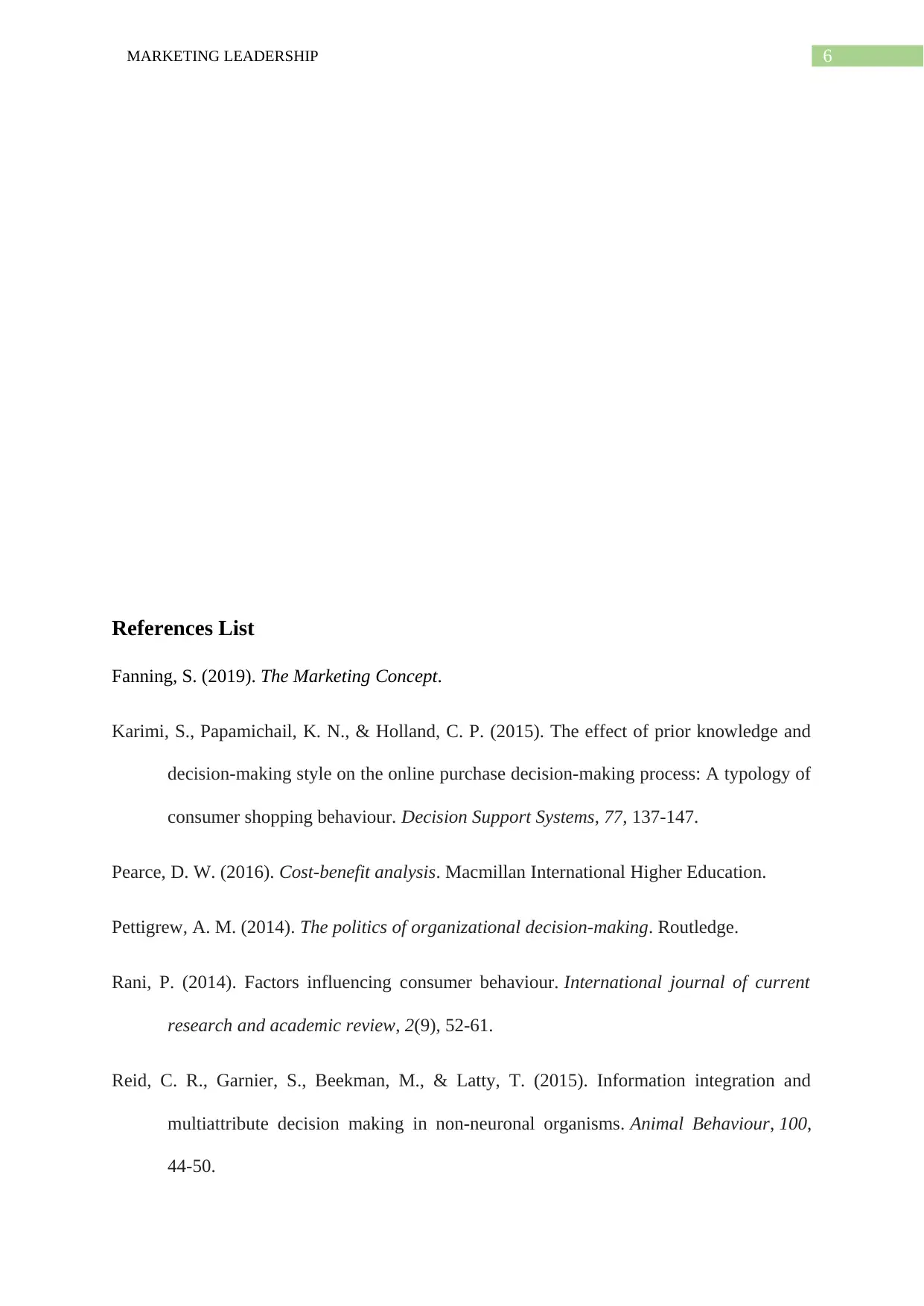
6MARKETING LEADERSHIP
References List
Fanning, S. (2019). The Marketing Concept.
Karimi, S., Papamichail, K. N., & Holland, C. P. (2015). The effect of prior knowledge and
decision-making style on the online purchase decision-making process: A typology of
consumer shopping behaviour. Decision Support Systems, 77, 137-147.
Pearce, D. W. (2016). Cost-benefit analysis. Macmillan International Higher Education.
Pettigrew, A. M. (2014). The politics of organizational decision-making. Routledge.
Rani, P. (2014). Factors influencing consumer behaviour. International journal of current
research and academic review, 2(9), 52-61.
Reid, C. R., Garnier, S., Beekman, M., & Latty, T. (2015). Information integration and
multiattribute decision making in non-neuronal organisms. Animal Behaviour, 100,
44-50.
References List
Fanning, S. (2019). The Marketing Concept.
Karimi, S., Papamichail, K. N., & Holland, C. P. (2015). The effect of prior knowledge and
decision-making style on the online purchase decision-making process: A typology of
consumer shopping behaviour. Decision Support Systems, 77, 137-147.
Pearce, D. W. (2016). Cost-benefit analysis. Macmillan International Higher Education.
Pettigrew, A. M. (2014). The politics of organizational decision-making. Routledge.
Rani, P. (2014). Factors influencing consumer behaviour. International journal of current
research and academic review, 2(9), 52-61.
Reid, C. R., Garnier, S., Beekman, M., & Latty, T. (2015). Information integration and
multiattribute decision making in non-neuronal organisms. Animal Behaviour, 100,
44-50.
Paraphrase This Document
Need a fresh take? Get an instant paraphrase of this document with our AI Paraphraser
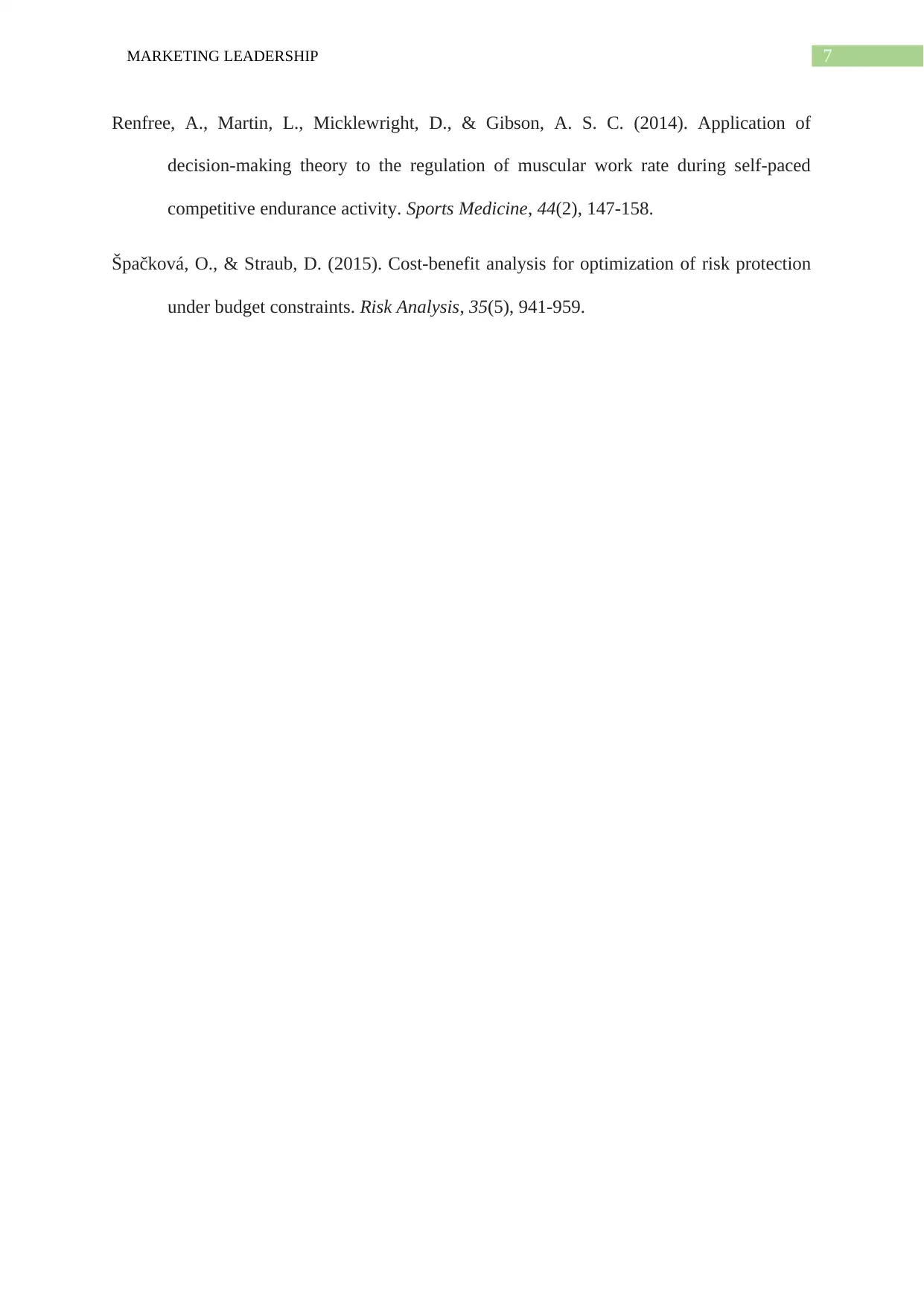
7MARKETING LEADERSHIP
Renfree, A., Martin, L., Micklewright, D., & Gibson, A. S. C. (2014). Application of
decision-making theory to the regulation of muscular work rate during self-paced
competitive endurance activity. Sports Medicine, 44(2), 147-158.
Špačková, O., & Straub, D. (2015). Cost‐benefit analysis for optimization of risk protection
under budget constraints. Risk Analysis, 35(5), 941-959.
Renfree, A., Martin, L., Micklewright, D., & Gibson, A. S. C. (2014). Application of
decision-making theory to the regulation of muscular work rate during self-paced
competitive endurance activity. Sports Medicine, 44(2), 147-158.
Špačková, O., & Straub, D. (2015). Cost‐benefit analysis for optimization of risk protection
under budget constraints. Risk Analysis, 35(5), 941-959.
1 out of 8
Your All-in-One AI-Powered Toolkit for Academic Success.
+13062052269
info@desklib.com
Available 24*7 on WhatsApp / Email
![[object Object]](/_next/static/media/star-bottom.7253800d.svg)
Unlock your academic potential
© 2024 | Zucol Services PVT LTD | All rights reserved.


